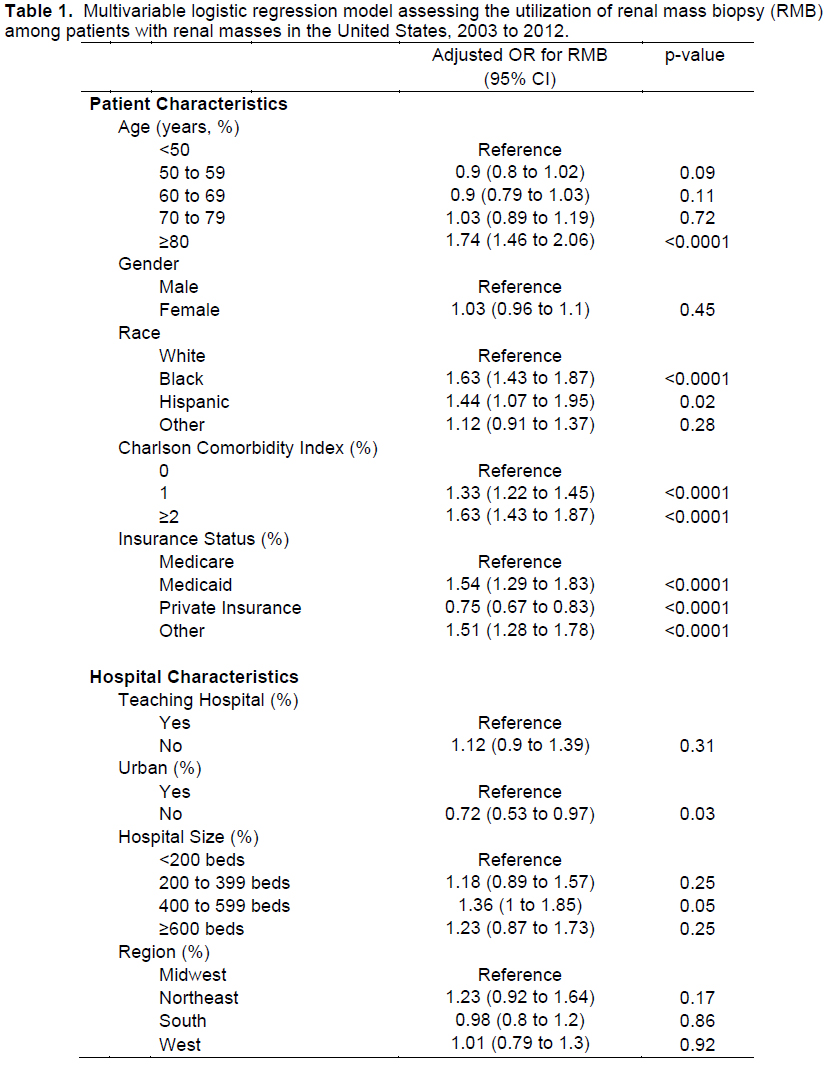|
Back to 2014 Annual Meeting Abstracts
Trends in the Utilization of Percutaneous Renal Mass Biopsy to Guide the Management of Renal Masses: a Population-Based Analysis
Tudor Borza, MD1, Jeffrey Leow, MPH1, Ramdev Konijeti, MD1, Adam Feldman, MD2, Benjamin Chung, MD3, Steven Chang, MD1.
1Brigham and Women's, Boston, MA, USA, 2Massachusetts General Hospital, Boston, MA, USA, 3Stanford University Medical Center, Palo Alto, CA, USA.
BACKGROUND:
The traditional paradigm for the management of renal masses involves therapy without a tissue diagnosis. However, there is a growing body of evidence supporting the use of percutaneous renal mass biopsy (RMB) to guide therapy to identify tumors not appropriate for surgery. Therefore, we sought to characterize trends in RMB utilization using a population-based cohort.
METHODS:
We captured patients with a renal mass in the Premier Perspective Database (Premier, Inc, Charlotte,NC), a nationally representative
hospital discharge between 2003 to 2012. Subjects were identified as having a renal mass based on ICD9 codes (189.0-189.1, 196.x, 198.8x, 223.0-223.1, 236.91, 593.2, 594.9, 753.3, V10.52-V10.53). Patients were assumed to have a RMB to guide therapy if it was performed on a date separate from any intervention including radical nephrectomy (55.51,
55.52, 55.54), partial nephrectomy (55.4), ablation (55.32-55.39) and
percutaneous renal biopsy (55.23). We performed trend analysis to assess RMB utilization and multivariable logistic regression adjusting for survey weights and hospital clustering to identify characteristics associated with RMB utilization.
RESULTS:
Our study cohort included a weighted sample of 444,407 patients with renal masses and 38,980 who underwent a RMB to guide therapy. Trend analysis demonstrated that the proportion of patients undergoing RMB has remained stable at 8-9% annually during the study period. Predictors
of undergoing RMB included age ≥80, African-American and Hispanic ethnicity, elevated Charlson Comorbidity Index, coverage with Medicaid or Other insurance while predictors for not undergoing RMB included age from 60-69, private insurance, and rural hospitals (Table 1).
CONCLUSIONS:
In the United States, RMB is an underutilized for patients with renal masses, and the proportion of patients undergoing this test has not changed despite recent literature supporting the use of this diagnostic test. We speculate that RMB is preferentially used to confirm a malignancy in patients who are poor candidates for intervention. Further research into the appropriate indications and the barriers to use for RMB is warranted.

Back to 2014 Annual Meeting Abstracts
|

|

